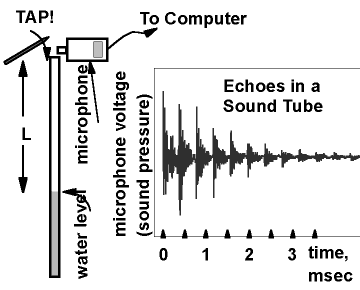Experiment of The Month
Higher Technology Sound Velocity of Sound
The MU Physics Department does not claim to have invented these labs. The origin of these labs is currently unknown to us. Our labs do not have written instructions. In keeping with this spirit, the description given here will be brief and general. The intent is that each performance of the lab will be unique; in each nature will reveal a slightly different face to the observer.
The Physics Department carefully protects these two aspects of physics laboratory instruction at MU:
1) Each laboratory instructor has a Ph.D. in Physics.
2) There are no written instructions for the exercises that we do in the laboratory.
This combination means that each exercise is subtly adjusted to the interests of the class and the professor. The lack of written instructions allows experimentation and improvement without editorial approval. The professors are "light on their (academic) feet," and able to implement new ideas quickly.
We recently installed the MultiPurpose Laboratory Interface (by Vernier Software) in our laboratory computers. Initially, they were used with ultrasonic distance rangers to measure and record the position of objects as a function of time. The interface (called MPLI for short) was used to capture data at a rate of about 100 readings per second.
However, the MPLI is capable of taking data at tens of thousands of readings per second. This feature was exploited last spring in a revised measurement of the speed of sound. The new measurement takes place completely indoors, but still measures the transit time of sound echoes, as we did the previous version.
A sketch of the revised experiment is shown in the figure.

The same tubes that are used to observe sound standing waves are used. The tube is partially filled with water, which provides the reflecting surface. The top of the tube is tapped lightly with a pencil. A microphone connected to the MPLI voltage input allows the computer to record the original tap and multiple echoes as the sound pulse
Our technician, Shawn Reinfried, took those data points, using an air column length of 65 cm. Some skill in tapping produces a variety of pulse shapes; some sharper (and easier to measure) than others. The time increases as the level of the water decreases, indicating that the echoes indeed come from the surface of the water.
Following our usual philosophy, students measure the sound using this "time of flight" method, then apply the results to predict the outcome of a standing wave experiment in the same tube. Uncertainties are
-
Contact Information
Contact Number: 717-871-4297
Email: physics@millersville.edu